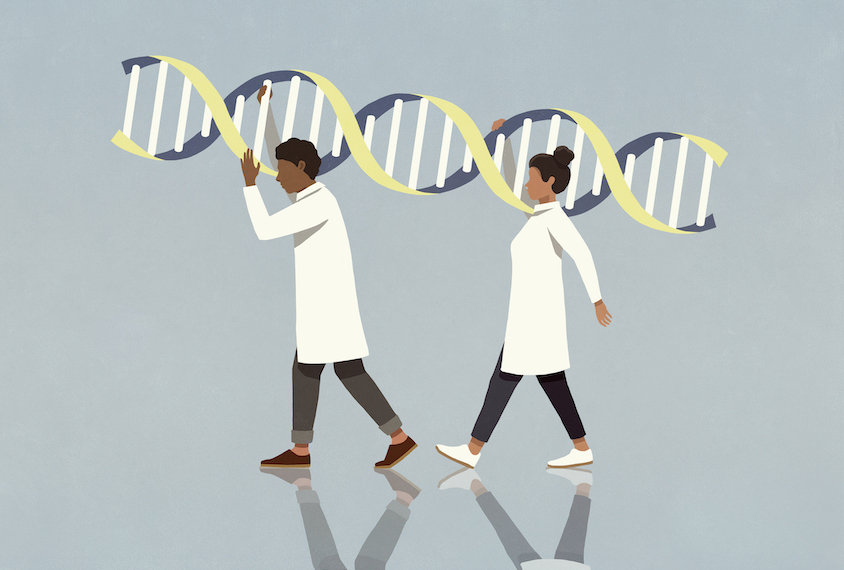Starting things off this week is a thread by Jonathan Sebat, professor of psychiatry and cellular and molecular medicine at the University of California, San Diego, calling out autism research’s focus on gene lists.
Every autism research meeting for the last 5 years
1) Synopsis of autism genetics from some perennial session chair in the field, culminating in “here is our current list of genes”
2) Scientists from epigenomics and neuroscience: “what are we going to do with this gene list”— Jonathan Sebat (@sebatlab) August 23, 2022
He tweeted that much needs to be understood “about genes -> mechanisms -> phenotype IN HUMANS that requires well powered human studies. But somehow the human research has been reduced to ‘studies that produce gene lists.’” Sebat explained further, “Once a gene is found, the human genetics becomes an afterthought. I got news for you. One gene doesn’t cause autism. Genetics is just as important in translation!”
The problem IMHO is that “translational” science is considered the purview of neuroscience and clinical psychology. Once a gene is found, the human genetics becomes an afterthought. I got news for you. One gene doesn’t cause autism. Genetics is just as important in translation!
— Jonathan Sebat (@sebatlab) August 23, 2022
“With all these gene lists we have hundreds and hundreds of genes to functionally characterize,” replied Maddie Gillentine, a geneticist at Seattle Children’s Hospital in Washington. She also pointed out the high cost and difficulty of designing studies that will impact a large number of genetic conditions.
Sebat responded, “Clinical studies should not focus on 1 or 2 disorders. It’s a big science problem that requires large scale collaboration.”
Clinical studies should not focus on 1 or 2 disorders. It’s a big science problem that requires large scale collaboration
— Jonathan Sebat (@sebatlab) August 24, 2022
Michael Gandal, assistant professor of psychiatry and biobehavioral sciences at the University of California, Los Angeles, tweeted in agreement that “the major lesson human genetics has taught us is sample size absolutely critical to robustly assess allelic effects in population.”
Could not agree more. But also the major lesson human genetics has taught us is sample size absolutely critical to robustly assess allelic effects in population. Same principles will apply to identify mechanisms
— Michael Gandal (@mikejg84) August 24, 2022
In a separate thread, Joseph Gleeson, professor of neurosciences at the University of California, San Diego, shared an unpublished study that used 33 genetically diverse strains of mice to model mutations in CHD8, a top autism candidate gene.
Gleeson tweeted that the paper “uncovers both susceptibility and resiliency of individual strains towards #autism-related traits.”
Impactful paper from the great Pat Levitt of #usc. #CHD8 haploinsufficiency in the mouse #CollaborativeCross background uncovers both susceptibility and resiliency of individual strains towards #autism-related traits. Very impressive! https://t.co/K1AbaOCqQ0
— Joseph G. Gleeson (@jogleeson_ucsd) August 27, 2022
“As this study and others nicely show, important aspects of biology and disease are missed with a unitary focus on a single strain,” replied Mark Zylka, professor of cell biology and physiology at the University of North Carolina at Chapel Hill.
Neuroscientists primarily use C57Bl/6 mice. As this study and others nicely show, important aspects of biology and disease are missed with a unitary focus on a single strain. Similar strain dep differences also found by others for ALZ, seizures, pain.
— Mark Zylka (@MarkZylka) August 27, 2022
“Grateful to work with Pat and Allison and for their groundbreaking work that made this study possible,” tweeted study author Manal Tabbaa, behavioral researcher at the University of Southern California in Los Angeles.
In another thread, James McPartland, professor of child psychiatry and psychology at the Yale Child Study Center, shared his study which used electroencephalography (EEG) to track children’s brain responses at rest and during several tasks. A delay in the brain response to viewing faces — called the N170 — distinguished autistic children from their non-autistic peers.
The results “provide information about EEG biomarker performance that is relevant for the next stage of biomarker development efforts focused on context of use,” according to the study.
New from #ABCCT led by @PBSLab_Webb https://t.co/hO5wUdotsN
— James C. McPartland (@J_McPartland) August 24, 2022
“Much-awaited EEG results from #ABCCT finally published, demonstrate pretty robust psychometrics,” wrote Zack Williams, a medical and doctoral student at Vanderbilt University in Nashville, Tennessee, in a quote tweet.
Much-awaited EEG results from #ABCCT finally published, demonstrate pretty robust psychometrics. Especially impressive #N170 results given convergence with EU-AIMS findings earlier this month! Congrats @J_McPartland and the hundreds of folks who made this happen! https://t.co/eDsBJK2J08
— Zack Williams (@QuantPsychiatry) August 24, 2022
Continuing in the same thread, Williams tweeted, “The N170 ERP in particular has great potential as a “stratification biomarker” that could be used to subgroup autistic people into potentially more biologically homogeneous groups, making it easier to detect treatment effects in clinical trials.”
The N170 ERP in particular has great potential as a “stratification biomarker” that could be used to subgroup autistic people into potentially more biologically homogeneous groups, making it easier to detect treatment effects in clinical trials. https://t.co/0bku0tKfpl
— Zack Williams (@QuantPsychiatry) August 26, 2022
Twitter user @asdhominem brought up a concern that “instead of stratification this will become a means of excluding people based on ‘bio markers’ discovered from biased samples.”
My concern is that instead of stratification this will become a means of excluding people based on “bio markers” discovered from biased samples. It’s like using biased training data in ML. Infact it’ll be worse when we start throwing ML at this data as some studies have.
— STUDENT TWEETER. Please Be Patient. (@asdhominem) August 27, 2022
That’s it for this week’s Community Newsletter! If you have any suggestions for interesting social posts you saw in the autism research sphere, feel free to send an email to [email protected].
Follow us on Facebook, Twitter (@Spectrum), Instagram and LinkedIn.
Subscribe to get the best of Spectrum straight to your inbox.






